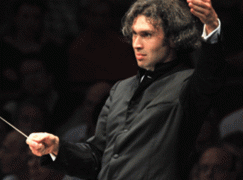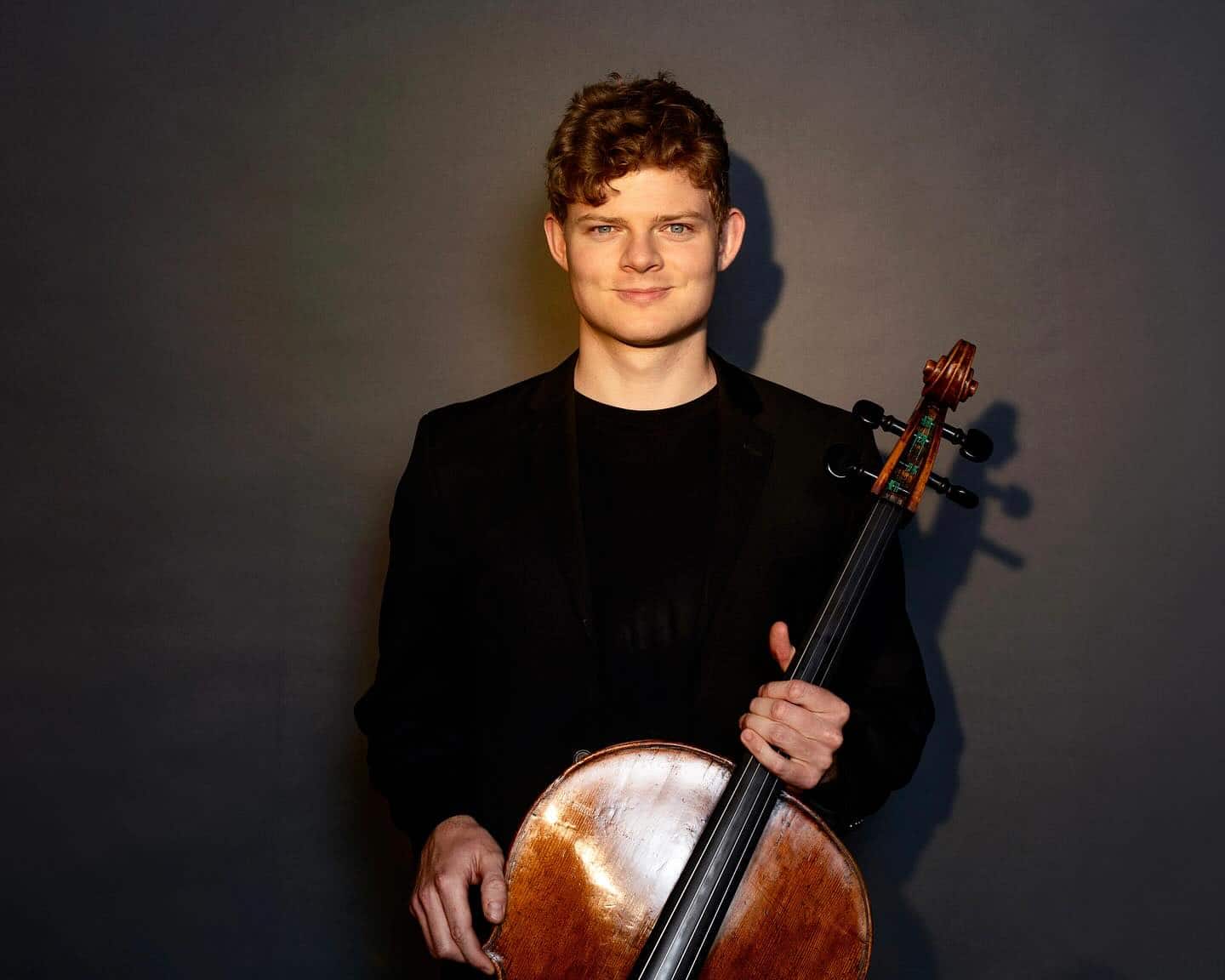Maestro move: Vladimir Jurowski takes Berlin job
mainThe London Philharmonic and Svetlanov Symphony (Moscow) Orchestra chief conductor has added a third job to his portfolio.
He will succeed Marek Janowski next year as chief conductor of the Berlin Radio Symphony Orchestra (RSB). Jurowski, 43, lives with his family in Berlin.






Here is a list of the 8 full time orchestras in Berlin. It also has 3 full time opera houses. The city is half the size of New York and London.
1 Orchester der Komischen Oper Berlin
2 Orchester des Metropol-Theaters, Berlin
3 Rundfunk-Sinfonieorchester Berlin
4 Orchester des Theaters des Westens, Berlin
5 Konzerthausorchester Berlin
6 Orchester des Friedrichstadt-Palastes (Show-Band)
7 Berliner Philharmoniker
8 Berliner Symphoniker
The orchestral landscape in Germany is astounding — 133 full time orchestras in a country with about the same area as Montana. To see the astoundingly dense map of the orchestras go here and scroll to page 5:
http://www.miz.org/static_de/themenportale/einfuehrungstexte_pdf/03_KonzerteMusiktheater/mertens.pdf
You forgot the DSO Berlin and the Staatskapelle…
So not with it William.
Theater des Westens hasn’t had it’s own orchestra for many years. Same with the former Metropol Theater, now Admiralspalast.
William, I too am a profound admirer of Berlin’s thriving music scene, but you need to update your sources. As Mathieu mentions, the DSO is conspicuous by its absence above, and if you are including the orchestra of the Komische Oper, then obviously the Staatskapelle Berlin and the orchestra of the Deutsche Oper belong on your list too.
Berlin’s music scene is indeed vivid, but it would be misleading to paint it all in rosy, Teutophilic (ach, those enlightened Germans!) hues. Numbers 2, 4 and 6 above are all defunct – and have been for some time. The Berliner Symphoniker is also no longer a full-time ensemble, as the orchestra had its public subsidy eliminated over a decade ago.
Many of Berlin’s now defunct or privatised institutional orchestras have been supplanted by more specialised, project-based ensembles such as the Kammerakademie Potsdam, the Akademie für alte Musik or the Mahler Chamber Orchestra (which admittedly has a limited concert presence in Berlin but is based in the city). These exist on little to no public subsidy, and, while creatively progressive, offer musicians none of the long-term job security of yesteryear.
I do not argue these alternative models are either positive or negative developments, only suggest William might wish to consider more nuanced appreciation of Berlin’s – and indeed Germany’s landscape. 133 orchestras may be impressive as compared to certain other countries (I suspect this is a jibe at the US, although why the surface area of Montana, with a population density comparable to Iceland or Botswana, is a relevant yard-stick eludes me), but the number has declined steadily over the last two decades. “High culture” in Germany faces its challenges too and smug triumphalism (as if outpacing the US were justification in itself) will not provide the answers.
William,
I am not questioning your endlessly repeated main point, but comparing Germany to Montana is misleading. Montana has a population of 1,024 million; Germany has 81 million. The most populous US State, California, has about 38 million inhabitants and an area about 18% bigger than Germany’s. That may be a better choice for comparison – and I am sure it is easy to demonstrate that Germany’s orchestral activity dwarfs California’s.
Don’t question him. I don’t want to hear again about the rankings of operas or about how great Stalin, Mao, Pol Pot, Castro and Chavez were.
European readers should remember that in the USA public arts funding is often equated with Stalinism.
Equating them is foolish, but being aware of important similarities between the two is perfectly reasonable.
Did you really say that?
Could you please elaborate on these “important similarities” between public arts funding and Stalinism? Please also specify the Universe, from which you are speaking.
Government’s control of art funding leads to government’s control of arts – in any Universe.
So you prefer corporate control of the arts? Ouch.
No form of government is perfect and I hate to state the obvious, but in a democracy, the government is controlled by the people, at least to a good degree, you know? Now in a plutocracy like the US, not so much…
No, I prefer when arts are supported directly by people who are interested in supporting them, rather than by government-controlled bureaucracies that distribute taxpayers’ money according to government’s priorities. Of course, most “democracies” (including a far-from-perfect US version) are capable of doing a better job of it than “Stalinist” regimes ever could, which is why, as I said earlier, “equating is foolish”, but private model still remains the better solution.
Private sponsorship means sponsorship proportional to wealth. And that is supposed to be a better system than democratic/government sponsorship?
Makes no sense at all.
There are plenty of cases when less wealthy give more and vice versa; wealth helps certainly (which is why I never said that private funding was perfect) but fortunately it never is the sole determining factor. Government sponsorship, on the other hand – even with best intentions – is only as good as the bureaucrats who operate it. The bigger the government and its bureaucracy, the more those good intentions get swallowed by all kinds of decidedly non-artistic considerations.
Yes, that is also an interesting comparison. On the basis of population, CA would have about 65 full time orchestras instead of 2, but my comparison was about geographic density, not population. (See my post below.)
To Petros and the others, I wasn’t comparing populations but rather surface area — as explicitly stated. The geographic density of 133 full time orchestras in an area about the size of Montana is astounding. I took the list from the url which was published by the DOV and MIZ. Not sure why it has errors.
As for being Germanophillic, I am not, as regular readers of this blog will know. One could, for example, turn the argument around and be concerned about a country with such a close affinity to such an authoritarian and nationalistic art form. I closely consider both views.
Please define “authoritarian and nationalistic art form”. Makes no sense to me.
Read my article “Symphony Orchestras and Artist-Prophets: Cultural Isomorphism and the Allocation of Power In Music” published by the M.I.T. Press, which is available here:
http://www.osborne-conant.org/prophets.htm
still doesn’t make sense…
I was just brainstorming with a friend about Johann Sebastian Bach, his oeuvre, and the “authoritarian and nationalistic art form”. Then we tried with Beethoven, we tried with Mozart, we tried with Schubert, didn’t get anywhere…
This ignores that there is substantial overlap of players, To imply that each is a fully employed group of players, it is simple distortion.
Actually, there is very little overlap of players.
Great great catch by that orchestra. Jurowski is in my opinion the best conductor, overall musician and intellectual capacity in his profession. His weakness is his uncompromising character and at times very demanding approach, which inconveniences at times orchestra players and is possibly the only reason, why he is not actually chief conductor of one of the top ten bands in the world. I have heard an anecdote, where he told as guest conductor to a very prestigious German orchestra a few years ago after a dress rehearsal he found underwhelming, to go out and by a CD of “x” to learn how its really done. That’s the type of attitude that 50 years ago might have commanded respect, but is in todays more egalitarian orchestra world not accepted anymore.
Philadelphia, where he has been an enormous success, was extremely interested in him before the YNS hire, but he made it clear that his family would make it impossible to take an American job. I have become a big YNS fan but I never miss a Jurowski concert.
Yes, I wholeheartedly agree. Vladimir Jurowski is the one conductor whose London concerts I make an effort not to miss. The series of four concerts entitled ‘War and Peace: Music of the 1930s and 40s and World War II’ that he presented this July in Moscow with the Svetlanov Symphony Orchestra (and which is available in delayed streaming from medici.tv) was remarkable for both the range of its content (with performances of works by Britten, Dallapiccola, Hartmann, Lutoslawski, Martinu, Messsiaen, Myaskovsky, Schulhoff, Shostakovich and Walton, among others) and the insight that he brought to his commentaries on the music and its historical context.
Amazing that good conductors are in such short supply that people have three sometimes four positions. WOW such a shortage.
It’s not really that surprising. There are tons of great instrumentalists; the standard has never been higher. And it might explain why there are relatively few truly great conductors: Good conductors have to be able to convince a group of good musicians that they know how to interpret the music better than the musicians do, and to organize them in relatively limited time to do it. The better the musicians, more difficult it is to find people who are competent to lead them well. So the relatively few who can do it truly well are in short supply and, hence, great demand.
This was a little too quick, Mr Lebrecht. Neither RSB nor the Maestro has confirmed.
Would be beautiful if it happens, however!
I received confirmation late on Friday.
From where? Not from the orchestra, in any case.
He got no confirmation from anyone, but now that it has actually been announced he is going to pretend he doesn’t need to do a new news item because then he can claim it was old news…
The Palast Orchester was also not listed. It is capable of playing other than its idiom. It actually records for Universal, mainly Cabaret music, but it is a real Berlin orchestra.
One need add the Palast Orchester, which is a bona fide entity that plays principally Cabaret music, but is capable of pretty much playing anything on sheet music.